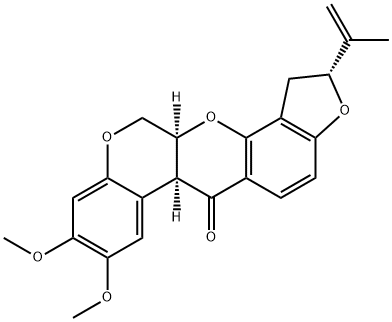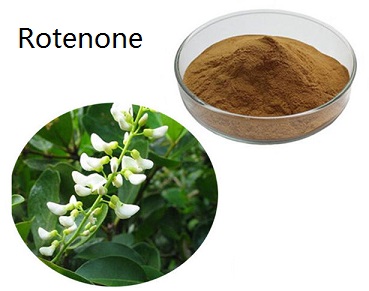Rotenone

- CAS No.
- 83-79-4
- Chemical Name:
- Rotenone
- Synonyms
- Rotenon;(1)Benzopyrano(3,4-b)furo(2,3-h)(1)benzopyran-6(6aH)-one, 1,2,12,12a-tetrahydro-2-alpha-iospropenyl-8,9-dimethoxy-;CUBE;gerane;Pyrethrum powder;(2R,6aS,12aS)-8,9-Dimethoxy-2-(prop-1-en-2-yl)-1,2,12,12a-tetrahydrochromeno[3,4-b]furo[2,3-h]chromen-6(6aH)-one;nekoe;Nusyn;canex;Cubor
- CBNumber:
- CB6397762
- Molecular Formula:
- C23H22O6
- Molecular Weight:
- 394.42
- MOL File:
- 83-79-4.mol
- MSDS File:
- SDS
- Modify Date:
- 2024/8/2 16:47:38
| Melting point | 159-164 °C (lit.) |
|---|---|
| Boiling point | 210-220 °C/0.5 mmHg (lit.) |
| alpha | -115 º (C=1.4 IN CHLOROFORM) |
| Density | 1.1917 (rough estimate) |
| refractive index | 1.4593 (estimate) |
| storage temp. | Keep in dark place,Inert atmosphere,Room temperature |
| solubility | insoluble in EtOH; insoluble in H2O; ≥77.6 mg/mL in DMSO |
| Water Solubility | 15 mg l-1 (100 °C) |
| form | White to off-white solid |
| color | White to Light yellow to Light orange |
| Merck | 14,8271 |
| BRN | 6773081 |
| Stability | Stable, but light and air sensitive. Combustible. Incompatible with oxidizing agents, especially in the presence of alkalies. |
| InChIKey | JUVIOZPCNVVQFO-HBGVWJBISA-N |
| NIST Chemistry Reference | Rotenone(83-79-4) |
| EPA Substance Registry System | Rotenone (83-79-4) |
SAFETY
Risk and Safety Statements
| Symbol(GHS) |   GHS06,GHS09 |
|||||||||
|---|---|---|---|---|---|---|---|---|---|---|
| Signal word | Danger | |||||||||
| Hazard statements | H300+H330-H315-H319-H335-H410 | |||||||||
| Precautionary statements | P260-P264-P273-P302+P352-P304+P340+P310-P305+P351+P338 | |||||||||
| Hazard Codes | T,N | |||||||||
| Risk Statements | 25-36/37/38-50/53 | |||||||||
| Safety Statements | 22-24/25-36-45-60-61 | |||||||||
| RIDADR | UN 2811 6.1/PG 3 | |||||||||
| OEB | B | |||||||||
| OEL | TWA: 5 mg/m3 | |||||||||
| WGK Germany | 3 | |||||||||
| RTECS | DJ2800000 | |||||||||
| HazardClass | 6.1(b) | |||||||||
| PackingGroup | III | |||||||||
| HS Code | 29329990 | |||||||||
| Toxicity | LD50 i.p. in mice: 2.8 mg/kg (Fukami); in rats (mg/kg): 132 orally; 6 i.v. (Soloway) | |||||||||
| IDLA | 2,500 mg/m3 | |||||||||
| NFPA 704 |
|
Rotenone price More Price(8)
| Manufacturer | Product number | Product description | CAS number | Packaging | Price | Updated | Buy |
|---|---|---|---|---|---|---|---|
| Sigma-Aldrich(India) | R8875 | Rotenone ≥95% | 83-79-4 | 1G | ₹7501.73 | 2022-06-14 | Buy |
| Sigma-Aldrich(India) | R8875 | Rotenone ≥95% | 83-79-4 | 5G | ₹23641.8 | 2022-06-14 | Buy |
| Sigma-Aldrich(India) | R8875 | Rotenone ≥95% | 83-79-4 | 10G | ₹37053.98 | 2022-06-14 | Buy |
| Sigma-Aldrich(India) | R8875 | Rotenone ≥95% | 83-79-4 | 25G | ₹73068.75 | 2022-06-14 | Buy |
| Sigma-Aldrich(India) | 557368 | Rotenone - CAS 83-79-4 - Calbiochem A mitochondrial toxin and a potent, reversible, and competitive inhibitor of complex I (NADH-CoQ reductase) of the respiratory chain. | 83-79-4 | 1G | ₹14370 | 2022-06-14 | Buy |
Rotenone Chemical Properties,Uses,Production
Description
The principal source of rotenone is the tuber root of Derris elliptica; however, it is also extracted from the roots of Derris mallaccensis, Lonchocarpus utilis, and Lonchocarpus uruca. Rotenone is both a stomach and contact poison for arthropods. Its fast knockdown action is attributed to decreasing the availability of nicotinamide adenine dinucleotide to serve as a cofactor in various biochemical pathways including the Krebs cycle, thereby inhibiting the mitochondrial respiratory enzymes.
Chemical Properties
Rotenone is a colorless to red odorless crystalline solid; a white crystalline solid when pure; oxidation will cause yellowing to bright red coloring. Odorless.

Rotenone is related to isoflavonoid compounds derived from the roots of Derris spp., Lonchocarpus spp., and Tephrosia spp., found primarily in Southeast Asia, South America, and East Africa. The isolated compound is an odorless, colorless to red crystalline solid. It is insoluble in water and has a very low vapor pressure (U.S. EPA, 2007; HSDB, 2012a).
Uses
Rotenone is an broad spectrum insecticide that occurs naturally in seeds and stems of several plants. Rotenone was first registered in 1947 and is currently used exclusively to kill fish (U.S. EPA, 2007). In 2006, registrants voluntarily canceled all livestock, residential and home owner uses, domestic pet uses, and all other uses except for piscicide uses. Currently the main uses include fish management strategies to remove nonnative fish species from lakes, ponds, or streams and in catfish aquaculture prior to stocking ponds with with fry to remove undesirable fish species (U.S. EPA, 2006d).
Rotenone has been historically used by native people to paralyze fish for capture and consumption. Outside the United States, the compound is still used to control insects in fruit and vegetable cultivation and for control of fire ants and mosquito larvae in pond water (HSDB, 2012a).
Definition
ChEBI: A member of the class of rotenones that consists of 1,2,12,12a-tetrahydrochromeno[3,4-b]furo[2,3-h]chromen-6(6aH)-one substituted at position 2 by a prop-1-en-2-yl group and at positions 8 and 9 by methoxy group (the 2R,6aS,12aS-isomer). A non-systemic insecticide, it is the principal insecticidal constituent of derris (the dried rhizome and root of Derris elliptica).
General Description
Colorless to brownish crystals or a white to brownish-white crystalline powder. Has neither odor nor taste.
Air & Water Reactions
ROTENONE decomposes upon exposure to light or air. Insoluble in water.
Reactivity Profile
ROTENONE is readily oxidized in the presence of alkalis. ROTENONE is incompatible with oxidizers. .
Hazard
Toxic by ingestion, overexposure can be fatal, irritant to skin, eyes and upper respiratory tract. Central nervous system impairment. Ques- tionable carcinogen.
Health Hazard
Rotenone is an irritant and affects the nervous system, causing convulsions.
Fire Hazard
Flash point data for ROTENONE are not available; however, ROTENONE is probably combustible.
Agricultural Uses
Insecticide, Acaracide, Veterinary medicine: The use of rotenone as a pesticide to kill invasive fish species is currently the only allowable use of this pesticide. Rotenone is a selective, nonspecific botanical insecticide with some acaricidal properties, and has been used in agriculture to control insects on vine fruit, flowers and vegetables. Registered for use in the U.S.A U.S. EPA restricted Use Pesticide (RUP) due to acute inhalation, acute oral, and aquatic toxicity. Agricultural and residential uses and all food uses were voluntarily cancelled in 2006[83]. In 2006, registrants requested voluntarily cancellation of all livestock, residential and home owner uses, domestic pet uses, and all other uses except for pesticide uses. In 2011 the use of this pesticide chemical was linked to Parkinson’s disease. Not listed for use in EU countries.
Trade name
ACME® Rotenone; AROL GORDON DUST®; BARBASCO®; BONIDE CUKE AND MELON DUST®; CENOL GARDEN DUST®; CHEM FISH®; CHEM-MITE®; CUBE®; CUBE EXTRACT®; CUBEPULVER®; CUBEROL®; CUBE ROOT®; CUBOR®; CUREX FLEA DUSTER®; DACTINOL®; DERIL®; DERRIN®; DERRIS®; DRI-KIL®; ENT-133®; EXTRAX®; FISH-TOX®; GREEN CROSS WARBLE POWDER®; HAIARI®; LIQUID DERRIS®; MEXIDE®; NICOULINE®; NOXFIRE®; NOXFISH®; PARADERIL®; POWDER AND ROOT®; PRENTOX®; PRO-NOX FISH®; RO-KO®; RONONE®; ROTACIDE®; ROTEFIVE®; ROTEFOUR®; ROTESSENOL®; SINID®; TOX-R®; TUBATOXIN®
Biological Activity
Mitochondrial electron transport chain inhibitor (IC 50 = 1.7 - 2.2 μ M at complex I). Inhibits NADH oxidation by cardiac sarcoplasmic reticulum (IC 50 = 3.4 nM). Commonly used pesticide and induces Parkinsonism in animal models. Cell-permeable and brain penetrant.
Potential Exposure
A potential danger to those involved in extraction from derris root, formulation or application of this insecticide. Rotenone is used as a pharmaceutical and veterinary drug.
Carcinogenicity
In human lymphocyte culture assays rotenone did not increase the frequency of chromosomal aberrations or sister chromatid exchanges but did cause an increase in the frequency of binucleated micronuclei and a delay in cell cycle.
Environmental Fate
Rotenone released to the atmosphere will exist as particulates due to the extremely low vapor pressure. Particulate-phase rotenone will be removed from the atmosphere by wet and dry deposition and may be degraded by direct photolysis. It is mobile to moderately mobile in soil and sediment and volatilization from soil surfaces is not expected to occur to any extent. If released to water, rotenone generally degrades quickly through abiotic (hydrolytic and photolytic) mechanisms, with half-lives of a few days to several weeks or longer depending on water temperature (U.S. EPA, 2007; HSDB, 2012a).
Rotenone has a relatively low potential for bioconcentration in aquatic organisms (Bioconcentration Factor (BCF) < 30X) (U.S. EPA, 2007).
Metabolic pathway
By hepatic microsomal incubations from rainbow trout with 14C-rotenone, three major and several minor metabolites of rotenone are observed, the major ones being identified as rotenolone and two epimeric forms of 6' ,7' -dihydroxyrotenone.
Shipping
UN2811 Toxic solids, organic, n.o.s., Hazard Class: 6.1; Labels: 6.1-Poisonous materials, Technical Name Required. UN2588 Pesticides, solid, toxic, Hazard Class: 6.1; Labels: 6.1-Poisonous materials, Technical Name Required.
Incompatibilities
Incompatible with oxidizers (chlorates, nitrates, peroxides, permanganates, perchlorates, chlorine, bromine, fluorine, etc.); contact may cause fires or explo- sions. Keep away from alkaline materials, strong bases, strong acids, oxoacids, epoxides, and alkalies.
Waste Disposal
Rotenone is decomposed by light and alkali to less insecticidal products. It is readily detoxified by the action of light and air. It is also detoxified by heating; 2 hours @ 100 ? C results in 76% decomposition. Oxidation products are probably nontoxic. Incineration has been recommended as a disposal procedure. Burial with lime would also present minimal danger to the environ- ment . In accordance with 40CFR165, follow recommen- dations for the disposal of pesticides and pesticide containers. Must be disposed properly by following pack- age label directions or by contacting your local or federal environmental control agency, or by contacting your regional EPA office.
Rotenone Preparation Products And Raw materials
| Supplier | Tel | Country | ProdList | Advantage | Inquiry |
|---|---|---|---|---|---|
| CLEARSYNTH LABS LTD. | +91-22-45045900 | Hyderabad, India | 6351 | 58 | Inquiry |
| A.J Chemicals | 91-9810153283 | New Delhi, India | 6124 | 58 | Inquiry |
| CHEMSWORTH | +91-261-2397244 | New Delhi, India | 6707 | 30 | Inquiry |
| TCI Chemicals (India) Pvt. Ltd. | 1800 425 7889 | New Delhi, India | 6778 | 58 | Inquiry |
| Maas Pharma Chemicals | +91-9958666224 | Delhi, India | 1607 | 58 | Inquiry |
| Hebei Kingfiner Technology Development Co.Ltd | +86-15532196582 +86-15373005021 | China | 2989 | 58 | Inquiry |
| Shaanxi Haibo Biotechnology Co., Ltd | +undefined18602966907 | China | 1000 | 58 | Inquiry |
| Hebei Jingbo New Material Technology Co., Ltd | +8619931165850 | China | 1000 | 58 | Inquiry |
| Chongqing Zhihe Biopharmaceutical Co., Ltd. | +86-18580541567 +86-17782035140 | China | 301 | 58 | Inquiry |
| Hebei Saisier Technology Co., LTD | +86-18400010335 +86-18034520335 | China | 996 | 58 | Inquiry |
83-79-4(Rotenone)Related Search:
1of4
chevron_right




